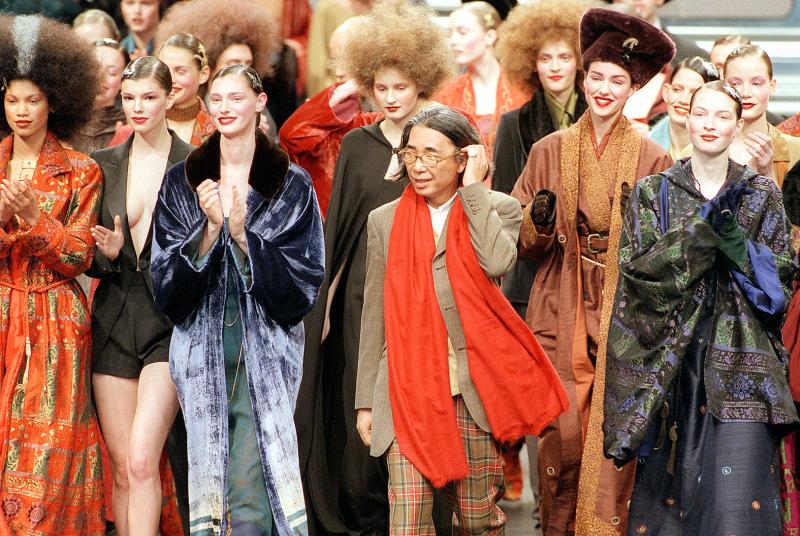The fashion world has paid tribute to the Japanese designer Kenzo Takada, who has died aged 81 after contracting COVID-19 in France, describing him as a man of “energy, kindness and talent” whose international outlook and attitude towards women’s clothes were ahead of their time.
Models and designers took to social media to pay tributes to Takada, who was commonly referred to by his given name, Kenzo.
“So sad to hear of your loss today... will always remember your smile and humble demeanour... and positivity you shined on us all,” Naomi Campbell said on her Instagram account. “Rest with the angels.”

Photo: AFP
Pat Cleveland, a pioneering African American model whom Takada championed, said her “heart was broken” over the death of her “dear friend.” She added: “He was such a joyful soul and I am going to miss him so much ... RIP darling Kenzo.”
Takada retired from his fashion house in 1999 to pursue a career in art, but remained one of the most respected figures in Parisian ready-to-wear.
The fashion critic Suzy Menkes said Takada continued to be an “emblem of international style” after the French luxury goods company LVMH bought the Kenzo brand in 1993.
“I remember him ... telling me that he wanted to make ‘happy’ clothes,” Menkes wrote. “That meant colorful, with a freedom for the woman’s body — and an international attitude way before his time.”
The artistic director of Kenzo, Felipe Oliveira Baptista, who showed his second collection for the brand on Thursday at Paris Fashion Week, said: “His amazing energy, kindness, talent and smile were contagious. His kindred spirit will live forever.”
Takada’s fellow designer and friend Giambattista Valli thanked him “for teaching me the generosity of sharing happiness,” adding, “I’m still dancing with you and I will dedicate any joyful moments to you! Bon Voyage precious friend.”
While his native Japan continued to inform his designs and lifestyle — his home in the heart of Paris, designed in part by Takado’s late partner Xavier de Castella, featured an authentic tea pavilion and a pool of carp — his career will always be most closely associated with his adopted home.
The designer’s death comes 50 years after he opened his first boutique in Paris.
The city’s mayor, Anne Hidalgo, described Kenzo as a “designer with immense talent, he gave color and light their rightful place in fashion,” she said. “Paris is today mourning one of its sons.”
Takada lived in Tokyo until the demolition of his apartment to make way for 1964 Olympics facilities proved the catalyst for his move to Europe the following year.
His work drew international attention after his designs were featured on the cover of Elle magazine in 1970.
“It is with immense sadness that Kenzo has learned of the passing of our founder,” the fashion house he founded said in a statement. “For half a century, Mr Takada has been an emblematic personality in the fashion industry always infusing creativity and color into the world.
“Today, his optimism, zest for life and generosity continue to be pillars of our Maison (House). He will be greatly missed and always remembered.”

Desperate dads meet in car parks to exchange packets; exhausted parents slip it into their kids’ drinks; families wait months for prescriptions buy it “off label.” But is it worth the risk? “The first time I gave him a gummy, I thought, ‘Oh my God, have I killed him?’ He just passed out in front of the TV. That never happens.” Jen remembers giving her son, David, six, melatonin to help him sleep. She got them from a friend, a pediatrician who gave them to her own child. “It was sort of hilarious. She had half a tub of gummies,

June 23 to June 29 After capturing the walled city of Hsinchu on June 22, 1895, the Japanese hoped to quickly push south and seize control of Taiwan’s entire west coast — but their advance was stalled for more than a month. Not only did local Hakka fighters continue to cause them headaches, resistance forces even attempted to retake the city three times. “We had planned to occupy Anping (Tainan) and Takao (Kaohsiung) as soon as possible, but ever since we took Hsinchu, nearby bandits proclaiming to be ‘righteous people’ (義民) have been destroying train tracks and electrical cables, and gathering in villages

The wide-screen spectacle of Formula One gets a gleaming, rip-roaring workout in Joseph Kosinski’s F1, a fine-tuned machine of a movie that, in its most riveting racing scenes, approaches a kind of high-speed splendor. Kosinski, who last endeavored to put moviegoers in the seat of a fighter jet in Top Gun: Maverick, has moved to the open cockpits of Formula One with much the same affection, if not outright need, for speed. A lot of the same team is back. Jerry Bruckheimer produces. Ehren Kruger, a co-writer on Maverick, takes sole credit here. Hans Zimmer, a co-composer previously, supplies the thumping

Swooping low over the banks of a Nile River tributary, an aid flight run by retired American military officers released a stream of food-stuffed sacks over a town emptied by fighting in South Sudan, a country wracked by conflict. Last week’s air drop was the latest in a controversial development — private contracting firms led by former US intelligence officers and military veterans delivering aid to some of the world’s deadliest conflict zones, in operations organized with governments that are combatants in the conflicts. The moves are roiling the global aid community, which warns of a more militarized, politicized and profit-seeking trend